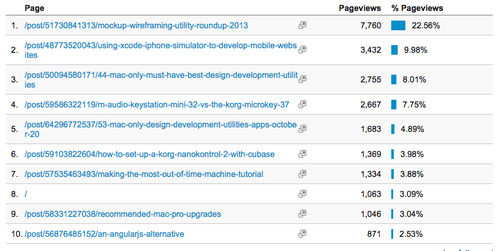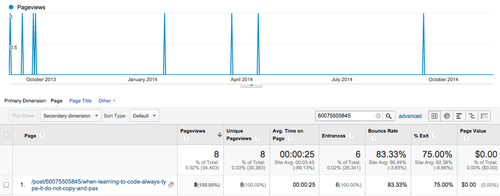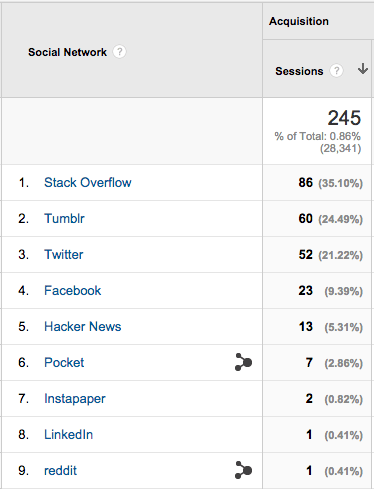Tumblr likes vs Page Views
On September 2, 2013, I wrote a post entitled “When learning to code always type it, do not copy and paste…“ It’s a clever anecdotal bit of advice that I read once on someone else’s blog. I’ve tried to track down the original source but have never been able to do so.
As of writing this, it has been liked 18 times and reblogged 8 times. That’s just a tiny ripple on Tumblr but its easily my biggest success in the Tumblr-verse.
The Tumblr platform
Tumblr’s biggest draw is its ability to easily reblog content from other sources. t is a novel idea as it allows content to be reshared on someone's own blog easily. The end result is usually a user’s collection of images and quotes that a user finds interesting or fits a theme. Combined with the ability to follow other bloggers, Tumblr has lead to the creation of range of large and diverse communities.
That said, I originally selected Tumblr as my blogging platform since it provided the right amount of customization, ease-of-use, and external management. Having set up more than a few Word Press blogs, I wanted to avoid maintenance as much as possible. The community aspect of Tumblr is a bonus, but I almost never participate in it, and almost never reblog or reshare content.
Statistically speaking, reblogging is an interesting proposition. Any time content is reblogged or found via the Tumblr hashtag search; it cannot be tracked by Google Analytics as the GA-code isn’t embedded within posts. However, I can track how many referrals I get from other blogs, as my posts are attributed to me and reblogged posts may create enough agency to drive someone to visit my blog.
How does this stack up against likes?
To better understand how likes translate to page views, it's important to understand what is normal traffic for my blog.

Weekly sessions (unique visitors) from September 2nd, 2013 to November 15th, 2014.
My blog gets roughly 600 sessions per week according to Google Analytics, meaning that it it gets roughly 600 separate visitors a week. A single session is defined by Google as a single visitor to the same website within a half hour period. If a repeat visitor comes to my blog twice within a half hour or clicks another page, this is counted as a single session. If a visitor revisits my blog 2 hours later, it is counted as a new session. Google Analytics also lets you track how many repeat visitor your web property receives.

Top 10 pages by Pageviews
One might expect my most liked post to show up in my top ten pages, since September 2nd, 2013, but it is plainly absent and doesn’t even appear within the top 100 posts on my blog. One might also expect that my top posts are nearly as successful on Tumblr as my most reblogged post.
My top post accounts for 22.56% of my traffic but only has 4 tumblr likes and 2 tumblr reblogs. In fact, none of the top five posts have more than 2 reblogs or 4 likes.

My most reblogged post has a grand total of 8 pageviews. The spikes in the above graphic represent a single page view.
As we can see, there’s almost no correlation between likes/reblogs and pageviews on a post. Perhaps, instead of driving pageviews to the reblogged/liked article, one again might assume Tumblr is driving more visitors to the first page of my blog, which isn’t the case.

Social media makes up for less than 1% of all the traffic to my blog and of that, Tumblr only accounts for 24.49% of social media traffic, meaning that Tumblr accounts for less than 0.25% of my entire traffic, tallying for a grand total of 60 visitors.
Processing the data…
What we can infer from this is that Tumblr rarely results in traffic acquisition for my blog. While I may get additional exposure from reblogs, it rarely results in anyone visiting my blog directly. Google Analytics reveals that there’s little correlation, if any, between likes/reblogs and pageviews. Tumblr also obfuscates traffic through reblogging and its own internal “follow” news feed. While I can see how many followers I have, its impossible to know how many people are reading my posts through Tumblr. My hunch is that it isn’t many.
Depending on the nature of the Tumblr blog, it is possible to be far more successful within the Tumblr-sphere than it is via web searches. People creating popular image macros/gifs/photos that aren’t easily indexed by search engines possibly see far more reblogs than pageviews.
While my case study can really only can accurately reflect what is true of my own blog, I’d be willing to bet in the case of technical blogs featuring long posts probably do not fair nearly as well on Tumblr. When gauging success, Google Analytics is a far better metric for this instance.